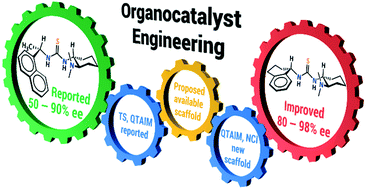Design and application of a bifunctional organocatalyst guided by electron density topological analyses†
Abstract
The design of new catalysts usually involves the synthesis and experimental evaluation of many compounds. We report herein an alternative methodology for designing bifunctional organocatalysts based on electron density topological analyses, i.e. the quantum theory of atoms in molecules and the non-covalent interaction index of the transition state (TS) of a Michael addition. These methods allowed us to identify key weak attractive interactions (CH⋯π) in the TS of a previously investigated catalyst. We sought a commercially available scaffold with the aromatic ring in the appropriate orientation to form such attractive interactions. We modelled the TS with this new scaffold and determined the occurrence of CH⋯π contacts by the aforementioned methodology. The new catalyst presented an excellent performance regardless of the substrate used in the reaction. Overall, this new approach shows how to exploit the quantum chemical topology as a tool to understand stereoselective reactions, successfully design bifunctional organocatalysts and avoid the synthesis of many catalysts.



 Please wait while we load your content...
Please wait while we load your content...